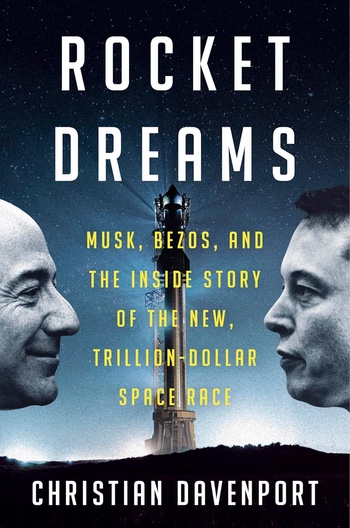Review: Rocket Dreamsby Jeff Foust
|
| “What can you do relative to the Moon by 2020?” one of transition team members asked. One company executive noted the progress on its New Shepard suborbital vehicle: “We can land something like it on the Moon.” |
The announcement took many by surprise, since NASA already has a CLPS task order awarded to Astrobotic for VIPER that it retained when it canceled VIPER last year. It is also contingent on Blue Origin demonstrating that Blue Moon can land on the Moon: while the full award is worth $190 million, the company is guaranteed only a fraction of that amount to do design work to accommodate VIPER on the lander, as well as demonstrate that Blue Moon can land safely on a demonstration mission planned for as soon as late this year.
It is, though, a victory for the company, and something of a vindication as well for a program that started almost as an accident. As Christian Davenport recounts early in his new book, Rocket Dreams, Blue Origin officials were meeting with members of the NASA transition team for the first Trump administration after the 2016 election. “What can you do relative to the Moon by 2020?” one of team members asked. One company executive noted the progress on its New Shepard suborbital vehicle: “We can land something like it on the Moon.”
It was, as Davenport notes, a “completely off-script” response since Blue Origin did not, at the time, have a lunar lander in development based on New Shepard. But it set gears in motion to develop one, which became Blue Moon.
Blue Moon is part of the larger competition between Blue Origin and SpaceX, and between their billionaire founders Jeff Bezos and Elon Musk, that is the theme of the book. It is a sequel to The Space Barons (see “Reviews: Rocket Billionaires and The Space Barons”, The Space Review, March 26, 2018), his earlier account of commercial space competition that included Bezos and Musk, among others.
Rocket Dreams is devoted principally to the competition between the two billionaires in space, and how that interacts with a NASA refocused on a human return to the Moon starting in the first Trump administration. Artemis would rely on commercial capabilities, notably landers, to get NASA astronauts back on the Moon, an effort that takes on increasing urgency as China ramps up its efforts to land its own astronauts on the Moon by the end of the decade.
| SpaceX is as hard-charging as ever, even as the focus shifted from Falcon and Dragon to Starship. It’s Blue Origin that has seen a new urgency. |
This is a familiar story for readers of this publication as the book recounts the development of SpaceX’s Crew Dragon to restore NASA’s ability to get astronauts to the ISS, as well as work on Starship, as well as Blue Origin’s efforts to get into the game with its New Glenn rocket and Blue Moon. However, the book is filled with details behind the scenes at the two companies, and NASA, as they work on their various programs and grapple with political and personal drama. That makes the book enlightening even to those who have been following these events closely.
The book makes clear that, of the two companies, Blue Origin has changed more over the last decade. SpaceX is as hard-charging as ever, even as the focus shifted during that time from Falcon and Dragon to Starship. It’s Blue Origin that has seen a new urgency as Bezos, no longer the CEO of Amazon, devotes more time to the company; the hiring of Dave Limp as Blue Origin CEO in late 2023 also changed the culture. (Limp notably asked Bezos when being courted to take the job, “Is this a hobby or a business?”) Blue Origin is at least running faster now, even if the gap with SpaceX is as wide as ever.
The Moon gives Blue Origin an opportunity to take the lead on SpaceX in one area. If the first Blue Moon makes it to the lunar surface late this year or even next year, it will get there ahead of SpaceX’s Starship lunar lander for Artemis, as many warn the program may be years behind schedule (see “Go faster, somehow,” The Space Review, September 8, 2025.) Blue Origin has rarely achieved a spaceflight milestone ahead of SpaceX, so this is an opportunity that would literally be once in a Blue Moon.
Note: we are now moderating comments. There will be a delay in posting comments and no guarantee that all submitted comments will be posted.
